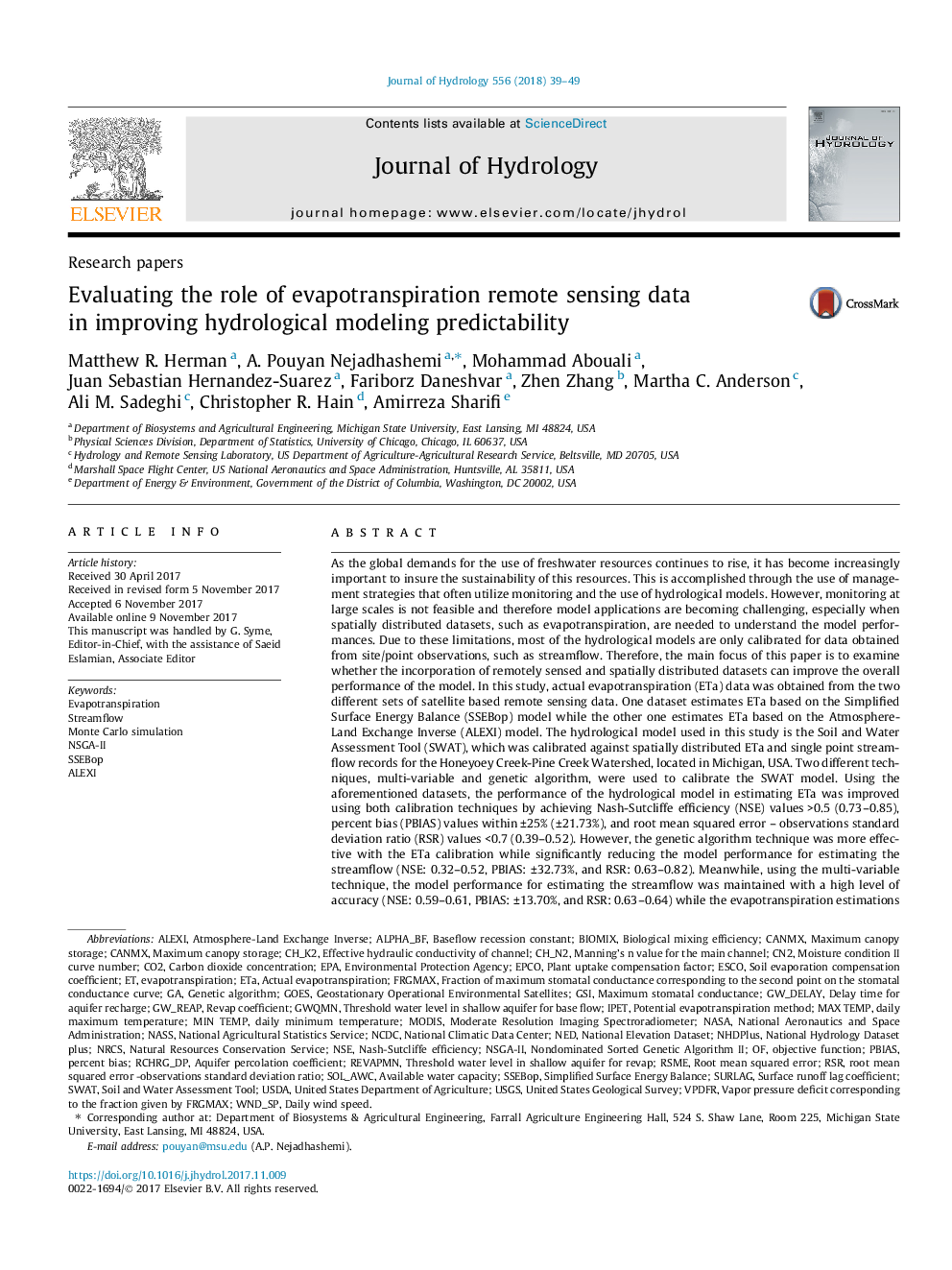| کد مقاله | کد نشریه | سال انتشار | مقاله انگلیسی | نسخه تمام متن |
|---|---|---|---|---|
| 8895097 | 1629898 | 2018 | 11 صفحه PDF | دانلود رایگان |
عنوان انگلیسی مقاله ISI
Evaluating the role of evapotranspiration remote sensing data in improving hydrological modeling predictability
ترجمه فارسی عنوان
ارزیابی نقش داده های سنجش از دور در تبخیر تعرق در بهبود پیش بینی مدل سازی
دانلود مقاله + سفارش ترجمه
دانلود مقاله ISI انگلیسی
رایگان برای ایرانیان
موضوعات مرتبط
مهندسی و علوم پایه
علوم زمین و سیارات
فرآیندهای سطح زمین
چکیده انگلیسی
As the global demands for the use of freshwater resources continues to rise, it has become increasingly important to insure the sustainability of this resources. This is accomplished through the use of management strategies that often utilize monitoring and the use of hydrological models. However, monitoring at large scales is not feasible and therefore model applications are becoming challenging, especially when spatially distributed datasets, such as evapotranspiration, are needed to understand the model performances. Due to these limitations, most of the hydrological models are only calibrated for data obtained from site/point observations, such as streamflow. Therefore, the main focus of this paper is to examine whether the incorporation of remotely sensed and spatially distributed datasets can improve the overall performance of the model. In this study, actual evapotranspiration (ETa) data was obtained from the two different sets of satellite based remote sensing data. One dataset estimates ETa based on the Simplified Surface Energy Balance (SSEBop) model while the other one estimates ETa based on the Atmosphere-Land Exchange Inverse (ALEXI) model. The hydrological model used in this study is the Soil and Water Assessment Tool (SWAT), which was calibrated against spatially distributed ETa and single point streamflow records for the Honeyoey Creek-Pine Creek Watershed, located in Michigan, USA. Two different techniques, multi-variable and genetic algorithm, were used to calibrate the SWAT model. Using the aforementioned datasets, the performance of the hydrological model in estimating ETa was improved using both calibration techniques by achieving Nash-Sutcliffe efficiency (NSE) valuesâ¯>0.5 (0.73-0.85), percent bias (PBIAS) values withinâ¯Â±25% (±21.73%), and root mean squared error - observations standard deviation ratio (RSR) valuesâ¯<0.7 (0.39-0.52). However, the genetic algorithm technique was more effective with the ETa calibration while significantly reducing the model performance for estimating the streamflow (NSE: 0.32-0.52, PBIAS: ±32.73%, and RSR: 0.63-0.82). Meanwhile, using the multi-variable technique, the model performance for estimating the streamflow was maintained with a high level of accuracy (NSE: 0.59-0.61, PBIAS: ±13.70%, and RSR: 0.63-0.64) while the evapotranspiration estimations were improved. Results from this assessment shows that incorporation of remotely sensed and spatially distributed data can improve the hydrological model performance if it is coupled with a right calibration technique.
ناشر
Database: Elsevier - ScienceDirect (ساینس دایرکت)
Journal: Journal of Hydrology - Volume 556, January 2018, Pages 39-49
Journal: Journal of Hydrology - Volume 556, January 2018, Pages 39-49
نویسندگان
Matthew R. Herman, A. Pouyan Nejadhashemi, Mohammad Abouali, Juan Sebastian Hernandez-Suarez, Fariborz Daneshvar, Zhen Zhang, Martha C. Anderson, Ali M. Sadeghi, Christopher R. Hain, Amirreza Sharifi,
